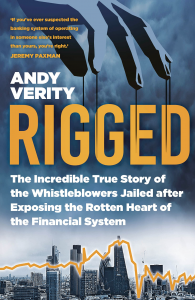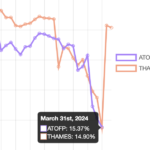
A book reviewer should declare any conflict of interest. This is particularly true in the case of “Rigged”, a book about the interest rate fixing scandal, which revolves around such conflicts.
In simple terms, someone working for a bank – a trader, or a junior clerical employee – submits a daily interest rate to a survey. The submitted rates from several banks are averaged, and the resulting magic number is the interest rate fix. These magic numbers go by different acronyms, but the best known is LIBOR: the London Inter Bank Offered Rate. LIBOR has been described as the most important number in finance, and trillions of dollars in mortgages and other assets are affected by it.
Where is the conflict of interest? LIBOR submitters, or others working at their bank, will have trading positions that will benefit if the magic number is higher or lower. This is the original sin of LIBOR fixing: adjust the submitted rate to make additional profits, and earn a higher bonus. Many bank employees have been charged, prosecuted and jailed for this crime.
But there were much more significant conflicts of interest in play; involving senior managers in banks, financial regulators, central banks, politicians, civil servants, and even the justice system itself. As a result, people have been sent to prison for doing something that was not a crime.
What is my conflict of interest? Well, I was one job interview away from appearing in this book. In 2002 I interviewed for a graduate position at the investment banking arm of Barclays Bank. Of around 75 places on the scheme, only two were for traders.
One of my interviewers was the managing director of UK interest rate trading. He did not hire me, instead preferring an Italian named Carlo Palombo. I got the other trader position, on the much smaller exotic derivatives trading desk.
I had a short and miserable career at Barclays, but suffered no long lasting harm. Carlo stayed at Barclays for a longer and his fate was far worse; he was convicted of fixing EURIBOR (another magic number) and spent several years in jail. Nobody can read the account of Carlo’s trial and imprisonment in “Rigged” without feeling sympathetic. But I also think: that could have been me.
Let us review what we all think we know about the LIBOR scandal. Some bankers agreed to change their submitted interest rates, they were caught, and went to jail. All of this has been told before in numerous newspaper articles, and in David Enrich’s book “The Spider Network” which focuses on one trader, Tom Hayes, who was given a fourteen year sentence. Case closed? Certainly- our instincts tells us that this must be a crime.
Look at the people doing it – bankers, getting paid millions of pounds a year. They enriched themselves in the 2008 crisis, during which there were numerous instances of outright fraud, mainly in the mortgage markets. However, almost none of them went to jail, at least not in the UK or US. LIBOR is used to set the rates of some mortgages, so these rate fixers are partly responsible for the mortgage crisis.
Also, look at how these people talk to each other:
• “its just amazing how libor fixing can make you that much money”
• “mate yur getting bloody good at this libor game … think of me when yur on yur yacht in monaco wont yu.”
• “Crack open the Bolly, Big Boy!”
• “I agree we shouldn’t ve been talking about putting fixings for our positions on public chat.”
These are clearly people who are doing something wrong, and I’m not just referring to their spelling. They sound like drug dealers, or perhaps drug dealers with a taste for ‘Bolly’ (Bollinger champagne) and yachts.
Andy Verity forces us to look beyond our prejudices, and examine whether this really is a clear case of egregious lawbreaking by overpaid bankers.
Firstly, consider the fixing process itself. The definition of LIBOR specifies a rate at which banks could borrow money at a specific time in the inter bank market. This is nearly always an estimate, since it’s unlikely a bank would be borrowing at that exact time. This was especially true during and after the 2008 crisis, when the interbank lending market dried up.
A trader can plausibly say that a particular LIBOR could easily be in a range of 3.12% to 3.16%, a range of four basis points (0.01%). But they have to submit a single number to the survey. The key question is this: are they allowed to allow commercial considerations to influence whether they pick 3.12%, 3.16%, or something in between?
The definition of LIBOR does not specifically prohibit or allow this behaviour. In “Rigged”, some judges are of the opinion that if such behaviour is not allowed, then it must be prohibited. But that is absurd, and goes against the way regulations work in finance and elsewhere. Perhaps there is a loophole here, and this could be considered unethical, but that does not make it illegal.
In fact it would be impossible to contribute to LIBOR if you could not take commercial considerations into account. A trader who has trading positions can’t just wipe their memory of these when submitting a rate. In one trial the inventors of EURIBOR were prepared to testify that the presence of a range in which commercial considerations could be used, was their intention when creating the benchmark, But the UK judge deemed this irrelevant.
Submitting LIBOR estimates in a narrow range with commercial considerations in mind was not only market practice, it was perfectly legal.
Did the fixing of LIBOR really affect the values of trillions of dollars of mortgages? Let’s do some brief calculations.
A banker might adjust their LIBOR estimate by perhaps a few basis points. Let us use a relatively large movement of 0.05%, and assume that the LIBOR submitter actually moved the rate in response to the traders request. With a LIBOR panel of 16 banks, only the eight banks in the middle of the survey will be used to calculate the final rate. If a bank pushes their rate too high or low, then they will be excluded. Instead we assume the trader is lucky, and they remain in the averaging process. Their 0.05% adjustment will move LIBOR by just 0.00625%.
This is a tiny amount and in any case, many people would have benefited from a slightly higher interest rate. Indeed, on many days LIBOR fixes would have been pushed lower; there was no systematic pressure in one direction. Ultimately is impossible to identify a specific individual who had suffered from a particular daily fix.
This is why prosecutors did not charge the traders with any crimes that required identifying the victims or the amounts they had lost.
Perhaps nobody was meaningfully harmed, but surely the traders still got rich? If I calculate the proportion of their bonus that they could have earned from adjusting LIBOR, the highest estimate I get is a few hundred pounds. Enough for a couple of bottles of champagne, but not for a yacht in Monaco or even Mablethorpe.
“Rigged” reveals a treasure trove of evidence about ‘lowballing’, a specific type of interest rate fixing that occurred during the financial crisis. It was directed by senior bank managers, central banks and politicians.
Their intention was to push LIBOR lower to make banks appear safer, and to reduce borrowing costs for the public. These are noble intentions, but this is exactly the same activity that the traders were involved in, with two important differences. Firstly, instead of a movement of a few basis points, the adjustment was much larger: fifty basis points was not uncommon (0.5%). The traders can point to the existence of a legitimate range of rates, but no such defence is possible here.
Secondly, none of the people involved in directing this activity has been convicted or even charged. And the senior bankers got to keep their bonuses: many times what the convicted junior traders earned – tens of millions of pounds. Enough for a decent sized yacht.
In a deeply ironic twist, the traders who whistle blowed about lowballing helped kick off the LIBOR investigation that led to some of them ending up in jail.
This book reveals a fundamentally broken justice system. Firstly, there were the US and UK regulatory agencies and prosecutors, who were convinced that someone had to go to jail, and refused to budge from that position. To take just two examples, UK prosecutors presented an expert witness who knew nothing about LIBOR, and in the US they lied to the court about the source of key evidence.
Secondly, we have an unequal extradition treaty that means US prosecutors could threaten UK traders with the prospect of a US trial, with a 90% conviction rate. This forced them to make false confessions in the hope of a shorter sentence, preferably served in the UK. Thirdly, the behaviour of judges in excluding important evidence that would have revealed evidence of lowballing, the complicit behaviour of senior managers, or explained the existence of the range.
The LIBOR fixing scandal is falsely described as a conspiracy, a particularly ironic label in the case of Tom Hayes who was the only person in his ‘criminal network’ to be convicted. But there is evidence of a real conspiracy here, a conspiracy to throw traders into prison for something that was not a crime, thus providing a convenient scapegoat for the financial crisis and to draw attention away from the far more serious activity of lowballing.
Along with the book, Andy has released audio files of the conversations between traders. Listening to senior bankers with plummy private school accents, and the ‘Essex boy’ traders with more plebian tones, it is no surprise that only the latter have been ended up in jail.
I have to ask myself: would I have done what Carlo did? Surely I would have refused to get involved. I do have integrity: there were things I had to do whilst at Barclays that I found unethical, albeit legal. So I left, and eventually became a whistle blower myself.
But I’m kidding myself. I would have done exactly what Carlo did. Put yourself in the shoes of these traders. They were employed, many from a young age in their first job, in an environment that in many ways is not that different to the army. Blokey banter of the type we see on the messages above was commonplace, and absolute obedience was expected.
You may think this is a poor metaphor, as “only following orders” is no defence for war crimes.
But a recruited soldier has to know the Geneva convention. These banking ‘soldiers’ were in most cases never shown the definition of LIBOR. They certainly were never given training explaining that they could not make tiny adjustments to LIBOR rates to reflect trader positions. Instead, they were told the exact opposite.
The magic number is no more; LIBOR will cease to be calculated at the end of this month (June 2023). For many it will become an interesting footnote in financial history, that will eventually be forgotten. But the ex-traders who have had their lives ruined will not be able to forget, and neither should we.
Robert Carver is a former interest rate derivatives trader, who has also worked as a quantitative hedge fund portfolio manager. He now trades independently and lives in Essex. Robert’s homepage is www.systematicmoney.org
 Levelling the Playing Field
Levelling the Playing Field
 Barclays and Labour's growth plan
Barclays and Labour's growth plan
 Plummeting bonds reflect souring UK mood for outsourcing and privatisation
Plummeting bonds reflect souring UK mood for outsourcing and privatisation
 Dimon rolls trading dice with excess capital
Dimon rolls trading dice with excess capital